Arto's Blog
Up and down the mountains in Northern Thailand and Laos
Posted: 2013-04-09 18:58:09, Categories: Travel, Thailand, Cycling, Laos, 1205 words (permalink)
 Our bicycle tour continued to Chiang Mai, the largest city in Northern
Thailand, and further North-East towards Laos. The landscape became
more mountainous and the roads climbed up and down with numerous
sharp curves. The temperatures were pleasantly a bit cooler than in
Central Thailand, due to the higher altitude and the surrounding
hills and mountains. Especially during the nights the temperatures
dropped, making blankets more useful than air condition.
Our bicycle tour continued to Chiang Mai, the largest city in Northern
Thailand, and further North-East towards Laos. The landscape became
more mountainous and the roads climbed up and down with numerous
sharp curves. The temperatures were pleasantly a bit cooler than in
Central Thailand, due to the higher altitude and the surrounding
hills and mountains. Especially during the nights the temperatures
dropped, making blankets more useful than air condition.
About 60 km north-east of Chiang Mai we came to the Bua Tong waterfall. We had seen several beautiful waterfalls a few days earlier in the Doi Inthanon national park, but Bua Tong totally surprised us. The water flowed down the cliffs in relatively small steps, which had a sandpaper like surface with a good grip. Children and adults alike were climbing up and down the falls, playing with the water. We naturally joined the party: a refreshing and fun experience!
 In Chiang Khong we crossed the border over the Mekong river to Huay
Xai, Laos. There we took a break from cycling and joined the Gibbon
Experience, a one and a half day trip to the jungle with
ziplines. Wearing a climbing harness and hanging from a metal wire,
one glides through the forest and above the treetops. It was a
series of exciting rides and great views to the nature at the same
time, with the longest ziplines being almost a kilometer long. The
night was spent in a treehouse, swinging gently in the wind several
dozen meters above the ground. We didn't see any gibbons, but
enjoyed the forest which had some magnificent giant trees. According
to the Gibbon Experience
website, the income of the activity is funding the protection of
the forest. Without deeper knowledge it's hard to say how large a
share truly goes to preservation, and how much building the ziplines
and riding them disturbs the nature, but I do believe it's a more
sustainable business model than logging and burning the forest to
fields.
In Chiang Khong we crossed the border over the Mekong river to Huay
Xai, Laos. There we took a break from cycling and joined the Gibbon
Experience, a one and a half day trip to the jungle with
ziplines. Wearing a climbing harness and hanging from a metal wire,
one glides through the forest and above the treetops. It was a
series of exciting rides and great views to the nature at the same
time, with the longest ziplines being almost a kilometer long. The
night was spent in a treehouse, swinging gently in the wind several
dozen meters above the ground. We didn't see any gibbons, but
enjoyed the forest which had some magnificent giant trees. According
to the Gibbon Experience
website, the income of the activity is funding the protection of
the forest. Without deeper knowledge it's hard to say how large a
share truly goes to preservation, and how much building the ziplines
and riding them disturbs the nature, but I do believe it's a more
sustainable business model than logging and burning the forest to
fields.
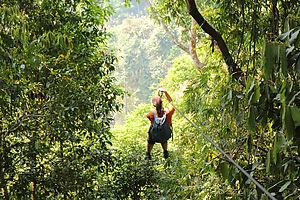 From Huay Xai we continued further east across Northern Laos. The
Lao road network is much less dense than in Thailand, so we couldn't
easily plan a route on secondary roads. Fortunately the main road
number 3 towards Luang Namtha was far from a busy highway, rather
resembling the countryside roads we had been cycling in
Thailand. The population density of Laos is less than a fifth of
that in Thailand, and only few people have cars. Heavily loaded old
trucks and minibuses occasionally unfreshened the air with thick
black clouds of exhaust while passing us, but the traffic density
was low enough not to bother us too much.
From Huay Xai we continued further east across Northern Laos. The
Lao road network is much less dense than in Thailand, so we couldn't
easily plan a route on secondary roads. Fortunately the main road
number 3 towards Luang Namtha was far from a busy highway, rather
resembling the countryside roads we had been cycling in
Thailand. The population density of Laos is less than a fifth of
that in Thailand, and only few people have cars. Heavily loaded old
trucks and minibuses occasionally unfreshened the air with thick
black clouds of exhaust while passing us, but the traffic density
was low enough not to bother us too much.
The road continued to go up and down large hills, with beautiful views down to the valleys on higher passes. The surface was paved and in good condition, a pleasure to ride. The land was partly covered by forest and partly deforested, with mainly Chinese and Vietnamese buying the wood. We saw many small rivers, which were generally cleaner than in Thailand, probably due to almost complete lack of any industry in the area.
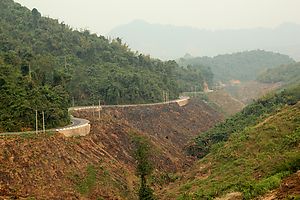 Both Lao and Thai people have a habit to burn patches of land,
often to prepare a field but sometimes with no apparent
purpose. Most of the burning happens between February and April,
which in combination of the long dry period makes the air misty and
dusty, like constantly being inside a thin cloud. It has not been
difficult to breathe but we have certainly felt the difference from
fresh and clear mountain air. We've also missed the blue sky, which
will only appear again when the rainy season begins in May or
June.
Both Lao and Thai people have a habit to burn patches of land,
often to prepare a field but sometimes with no apparent
purpose. Most of the burning happens between February and April,
which in combination of the long dry period makes the air misty and
dusty, like constantly being inside a thin cloud. It has not been
difficult to breathe but we have certainly felt the difference from
fresh and clear mountain air. We've also missed the blue sky, which
will only appear again when the rainy season begins in May or
June.
Roughly every five kilometers the road went through a small village. Children were happily waving and shouting "Hello" or "Sabaidee", often running to the roadside to meet us. They didn't have much but were laughing, playing and seemingly enjoying life. We rarely heard a child crying or anybody shouting in an angry voice. Adults were a bit more reserved but many still greeted us, staring, smiling and wondering why on earth were we pedaling all those uphills by bicycle when also motorcycles had been invented.
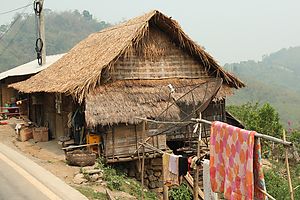 Most of the houses in villages were modest bamboo huts, probably
similar than they've been for hundreds of years, except being
nowadays equipped with electricity, tv and a satellite dish.
Cooking was still commonly done on fire and washing at the village
well. Here and there between the huts appeared fancier newer houses
built from concrete, especially in villages located near bigger
towns. Almost every village also had an elementary school, often
built with the support of some charity organization. That was the
situation in villages next to the main road. Rural villages tucked
between the mountains, many of them accessible only via narrow dirt
tracks, are apparently still less developed.
Most of the houses in villages were modest bamboo huts, probably
similar than they've been for hundreds of years, except being
nowadays equipped with electricity, tv and a satellite dish.
Cooking was still commonly done on fire and washing at the village
well. Here and there between the huts appeared fancier newer houses
built from concrete, especially in villages located near bigger
towns. Almost every village also had an elementary school, often
built with the support of some charity organization. That was the
situation in villages next to the main road. Rural villages tucked
between the mountains, many of them accessible only via narrow dirt
tracks, are apparently still less developed.
We cycled about 400 km from west to east via Luang Namtha and Oudomxay until Muang Khoua, a small town near the Vietnamese border. From there we took a two-day boat ride south on the Nam Ou river, finally joining the Mekong and arriving in Luang Prabang. The ride was very scenic, villages by the riverside only accessible by boat, fishermen, water buffaloes, small rapids, rock formations, sandy beaches and majestic mountains. Between the two days spent in the boat we stayed for two nights in Muang Ngoi, a riverside village transformed into a backpacker hangout as a result of all the boats stopping there. Despite the tourist crowds it was still a quiet and atmospheric place, having no cars and electricity only between 6 and 10 pm produced by a generator. That said, a new electricity line was just being installed and a road being built, which will certainly make a big change.
 In Luang Prabang we went to see some of the well-known sights. The
old and beautiful Xiengthong temple and the Kuang Xi waterfalls 30
km outside the city with idyllic turquoise pools were really worth a
visit. After that we headed again out to the countryside and started
cycling towards Phonsavan. The road was even a bit more mountainous
than earlier parts of our route, making some of the days quite
exhausting. Villages seemed to be a bit wealthier than in the
north, but ironically the first time children came to beg for candy
and money. It didn't happen often, but a few times during our ride
through the region.
In Luang Prabang we went to see some of the well-known sights. The
old and beautiful Xiengthong temple and the Kuang Xi waterfalls 30
km outside the city with idyllic turquoise pools were really worth a
visit. After that we headed again out to the countryside and started
cycling towards Phonsavan. The road was even a bit more mountainous
than earlier parts of our route, making some of the days quite
exhausting. Villages seemed to be a bit wealthier than in the
north, but ironically the first time children came to beg for candy
and money. It didn't happen often, but a few times during our ride
through the region.
Overall the pace of life in Laos is slow, slower than in Thailand. Selection in shops and on the markets is smaller, there is not much effort in arranging things attractively on the shelves and never a push to buy anything. Restaurants are serving more basic food, which however is usually tasty and not too spicy. Nobody seems to be in a hurry to go somewhere. This helps also the traveller to adopt a more relaxed and simple lifestyle. We will see how the atmosphere will change in a few days, during the celebration of Pi Mai, the Lao New Year. In addition to old traditions of cleaning homes and paying respect to the gods, the festivities include some wild partying and water throwing. In these temperatures being sprayed with water is a pleasure, so we're looking forward to joining and getting wet.
Wild elephants on the road
Posted: 2013-03-05 03:27:43, Categories: Travel, Thailand, Cycling, 787 words (permalink)
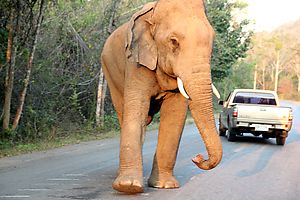 Sandra and I are now in Thailand and this photo shows one of our most exciting
moments during the first two weeks. We were riding a moped back from
Palau waterfall in Kaeng Krachan national park, when suddenly two
big wild elephants were walking towards us on the road. A Thai man
stopped his moped, turned around and adviced us to do the same. We
drove back a couple of hundred meters and watched how the beautiful
animals walked slowly forwards. One of them decided to return to the
forest, the other continued on the road.
Sandra and I are now in Thailand and this photo shows one of our most exciting
moments during the first two weeks. We were riding a moped back from
Palau waterfall in Kaeng Krachan national park, when suddenly two
big wild elephants were walking towards us on the road. A Thai man
stopped his moped, turned around and adviced us to do the same. We
drove back a couple of hundred meters and watched how the beautiful
animals walked slowly forwards. One of them decided to return to the
forest, the other continued on the road.
A car came from our direction and started slowly driving around the elephant. We followed behind the car together with the Thai motorist. Just as the car was passing, the elephant turned and started again crossing the road. The car and the Thai motorist got through, we weren't sure and stopped. Should we get off from the moped and slowly retreat on foot, or what should we do? Fortunately the elephant decided to stay in the middle of the road, leaving us enough space on the side. Sandra held her nerves well enough to point the camera towards the giant and take the photo.
We started our Thailand tour on the 14th of February by flying to Bangkok and taking a bus to Hua Hin. There we visited Sandra's father, who married a Thai woman after the early death of Sandra's mother, and who is now living in Thailand with his new family. In addition to meeting the family, Hua Hin was a good place to get adjusted to the climate, to try out Thai food and delicious fruits, to spend a bit of time on the beach, to enjoy a Thai massage, to visit a few temples and to get used to the left hand side traffic. The trip to Palau by moped was an exception, mostly we rode our bicycles which we brought with us.
After a week in Hua Hin we spent two days in Bangkok, which was a quite hectic experience after the more relaxed Hua Hin. We cycled once across the whole city from the western bus terminal to our hotel, which we had less wisely booked in the eastern part of Bangkok. After that we switched to public transport and walking. Once we rode motorcycle taxis, the fastest way to get around and an experience in itself. Of the most famous sights we went to see the big lying golden Buddha statue at Wat Pho, but skipped the Grand Palace. The backpacker oriented Khao San area was a bit more laid back, including roads without cars, with food stands on the side and foot massages outside in open air. We also shortly met my old friend Phisit, who kindly invited us for lunch near his workplace.
From Bangkok we took a train north to Phitsanulok and started our cycling tour. We rode first to Sukhothai spending one day around old temple ruins, and from there through the countryside and small towns towards Chiang Mai. Now we are at Chom Thong, near Thailand's highest mountain Doi Inthanon and the surrounding Doi Inthanon national park.
Especially smaller roads have been nice and motorists surprisingly polite. Cars and trucks mostly leave a large safety margin when overtaking us — sometimes vehicles coming from the opposite direction have to cope with a much less space than we do. People are yelling "Hello hello" from their houses when we're passing: the smaller the road the more attention we gather. A few times we've got spontaneous gifts such as bottles of drinking water or a watermelon. Unfortunately the locals' English ability is usually limited to the "Hello" and we don't speak enough Thai to really communicate with them.
Daily high temperatures are constantly over 35°C, and the sun shines strongly. We try to start relatively early in the morning and find accommodation latest early afternoon, leaving time to rest during the hottest time and to walk around later in the evening. Hotels and guesthouses are mostly easy to find, and cost around 400 Baht (10€) for a modern and clean room with air conditioning, less with fan only. Two times we stayed with CouchSurfing hosts, enjoying generous hospitality and learning more about the local culture and habits.
Staying connected in Thailand is quite easy nowadays. Almost all hotels and guesthouses have free wireless Internet. And when that's not available, we can use our one month / 1 GB mobile Internet package which we got for 500 Baht including the SIM card and some talk time. Phone calls with Thai SIM cards are cheap too, even when calling abroad. Roaming fees are absurdly high, so our Finnish and German cards we're keeping out of our phones.
Return to Helsinki
Posted: 2007-06-16 21:22:42, Categories: Travel, Finland, Thailand, Cambodia, Helsinki, Cycling, 473 words (permalink)
 My return trip which started from Phnom Penh went rather smoothly.
I pedaled towards the Thai border on the southern side of Tonle Sap
lake, stopping mainly to eat and sleep on the way. In the afternoon I
sometimes had a bit longer break to escape the heat, which exceeded 35
degrees on some days. In Phnom Sampeau I was once more hosted in a
Cambodian family, this time a restaurant owner with his wife and a few
months old son. He was searching for a foreign partner to open a
guesthouse in Siem Reap. I wasn't ready for that but it was still
interesting to talk with him.
My return trip which started from Phnom Penh went rather smoothly.
I pedaled towards the Thai border on the southern side of Tonle Sap
lake, stopping mainly to eat and sleep on the way. In the afternoon I
sometimes had a bit longer break to escape the heat, which exceeded 35
degrees on some days. In Phnom Sampeau I was once more hosted in a
Cambodian family, this time a restaurant owner with his wife and a few
months old son. He was searching for a foreign partner to open a
guesthouse in Siem Reap. I wasn't ready for that but it was still
interesting to talk with him.
Near the town of Pailin I crossed the border to Thailand and met my friend Phisit again in Chanthaburi. We visited once more his sister's fruit garden and returned to Phanathikhom. After one day of relaxing there I had my flight back to Helsinki from Bangkok airport. Once more I had to try to get through without overweight fees. I put my luggage on the scale, with the bicycle only halfway there — the display showed 23.3 kg and the girl behind the counter just smiled as they always do in Thailand. I smiled back and even the extra bag containing a selection of exotic fruits went through without problems.
In Finland I started by cycling from the airport to my parents' place with my friends Mikko and Sami. I wore only a t-shirt and shorts, which was a mistake resulting in a flu for the next couple of days. Mikko and Sami weren't suffering from cold in the same outfit so apparently my resistance to less than 30 degree weather had weakened in the warm countries.
In Helsinki it was surprising how easy it is to fill again your non-existing calendar. During the first six days I already met friends from the MikroPC magazine, hosted two French cyclists for a couple of days, visited my grandparents near Kotka and participated in my friend's graduation party. I also moved to my apartment in Haaga (in Northern Helsinki) and started to carry stuff back in. I began with the most important things such as installing the cd player, amplifier and loudspeakers. Otherwise arranging the flat hasn't progressed much, but it doesn't matter: I've got plenty of time to do it during the summer.
I won't stay in Helsinki for the whole summer, however. For the midsummer I'll head to Lapland beyond the arctic circle. Believe it or not, although I've lived in Finland for almost all my life it'll be the first time for me to experience the real midnight sun. I've seen plenty of nights during which it never becomes dark, but I have never been far enough in the north during the middle of the summer to see the sun up in the sky still at midnight.
Rain and rainforests
Posted: 2007-05-13 14:35:49, Categories: Travel, Thailand, 583 words (permalink)
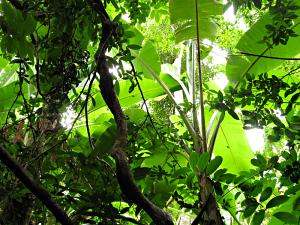 It has been rather rainy during the last two weeks, with showers
every day and a couple of days of more continuous rain. It
seems that the rainy season has started a few weeks earlier than
normally, at least that's what my Thai friend Phisit says. The good
news is that there's not much risk of getting a cold after becoming
wet. A good alternative for raingear is to simply wear light clothes
and sandals — they'll get dry later. Just after rain is also the
best time to go for a walk in a rainforest.
It has been rather rainy during the last two weeks, with showers
every day and a couple of days of more continuous rain. It
seems that the rainy season has started a few weeks earlier than
normally, at least that's what my Thai friend Phisit says. The good
news is that there's not much risk of getting a cold after becoming
wet. A good alternative for raingear is to simply wear light clothes
and sandals — they'll get dry later. Just after rain is also the
best time to go for a walk in a rainforest.
Phisit's brother took me about 50 kilometers east from Phanatnikhom to Khao Sha An cave and Ang Pak Nam waterfall. Neither of them are likely to be prominently mentioned in most travel guides, so there were few other people around.
The cave consisted of two large halls, one with a small shrine and another, darker one which had thousands of bats hanging from the roof. Even during daytime there was constant traffic around a hole leading to the open air, at night it must be quite a busy place! Fortunately all the activity concentrated near the top so it was safe to observe the bats from the floor.
The waterfall wasn't very spectacular, but the narrow path leading there through the rainforest was fascinating. I walked slowly admiring the amazing variety of vegetation around. There were large trees with lianes and other plants hanging from the branches, wild bananas and other treelike plants with large leaves, and of course many smaller plants filling the remaining space. When the rain stopped and sunlight entered where it found its way through the trees, butterflies woke up and were flying all around. The picture of this blog entry is from Ang Pak Nam and you can also take a look at a short video (about 5 MB) of walking through the forest. The section in the video is an easy one, in some places the path was quite slippery and you had to push through the bushes.
A few days later we went to Khao Yai national park, which is the most famous national park in Thailand. There the waterfalls were larger and we saw more animals. The most numerous were leeches, which tried to climb up our feet and legs to find a place where to suck blood. Fortunately they weren't too difficult to cast off. We saw also many other insects and worms, plenty of deer, a leguan and a fox, but no specialities such as big cats and wild elephants which also live in the park. It was interesting just to stop somewhere in the middle of the path and listen to the concert of animal sounds, some of them quite loud. However, for the plants I think Ang Pak Nam boasted a larger number of species in a small area. Besides, it didn't cost anything whereas at Khao Yai they charged a hefty 400 baht (9 euros) foreigner fee.
After two weeks of mainly sightseeing by car and staying at Phanatnikhom I finally resumed cycling on Saturday 12.5. The roads in Thailand are generally in good condition and I was able to travel 200 km easily in two days. However, that may change soon as I'm posting this in Aranyaprathet which is only six kilometers from the Cambodian border. According to Tales of Asia the road to Siem Reap and further to Phnom Penh should be in reasonable condition now, but there might be some muddy detours or other surprises on the way.
Thailand sightseeing in Japanese style
Posted: 2007-05-07 16:17:53, Categories: Travel, Thailand, 1039 words (permalink)
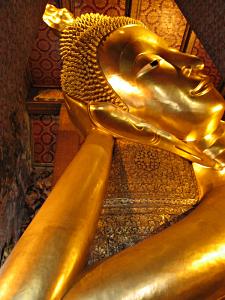 I started my stay in Thailand as a guest of Phisit, a friend I had met
during my exchange year in Japan. Just two days after my arrival the
parents of his Japanese host family came for a four-day visit, and
Phisit invited me to travel together with them. I hadn't taken a
single guided package tour during my trip, but this time the itinerary
was set, hotels were reserved in advance and we had a car to move
around. I switched to extra shutter-happy mode (averaging more than
hundred photos per day), tried to blow off the dust on my Japanese and
joined in.
I started my stay in Thailand as a guest of Phisit, a friend I had met
during my exchange year in Japan. Just two days after my arrival the
parents of his Japanese host family came for a four-day visit, and
Phisit invited me to travel together with them. I hadn't taken a
single guided package tour during my trip, but this time the itinerary
was set, hotels were reserved in advance and we had a car to move
around. I switched to extra shutter-happy mode (averaging more than
hundred photos per day), tried to blow off the dust on my Japanese and
joined in.
We began by picking up the Japanese couple at the Suvarnabhumi airport near Bangkok and driving south-east to Chanthaburi, an area famous for fruits. It was the beginning of harvest season and a friend of Phisit had a large fruit garden just outside the city. We spent a couple of hours eating as many durians, salaks, mangosteens, longkongs and rose apples as we could. Durians are the favourite fruit of many Thais, but I preferred mangosteens and longkongs. To be sure not to run out, at least twenty kilos more were loaded in the trunk before we moved on. On the way back we took a short walk in the tropical forest in a national park and in the evening had a feast at Phisit's brother's house in Phanatnikhom, about 80 km from Bangkok. Bananas and mangoes from his garden were added to the fruit plate.
On Tuesday the 1st of May we had again some fruit for breakfast and headed to Pattaya, one of the most popular beach resorts in Thailand. Tourism is already the most important source of income for the country and in Pattaya there was absolutely no doubt about it. Streets were lined with guesthouses and high-rise luxury hotels, restaurants, cloth and souvenir shops and Thai massage parlors. The beach was full of sun chairs most of which were empty due to the rainy weather, but a few speedboats and jet skis were still buzzing in front. At night time the main road was converted to a walking street, signs advertising go-go girl shows were lit, touts started competing with lines such as "Naughty girls, draught beer 55 baht" and bars filled up.
Phisit had arranged us a stay in four-star Pattaya Park Beach Resort. With off-season discounts just less than 20 euros per head bought us a suite room for four, including a sumptuous breakfast buffet and access to the hotel's large waterpark with different pools and slides. In the evening we took the elevator up to the revolving restaurant in the hotel tower and enjoyed a dinner buffet 170 meters above sea level. After that we still had time for a cabaret show in club Alcazar in the center of the town. The costumes and decorations were superb and the choreography also fairly good, but dancing was mediocre and songs mostly playback instead of live performances.
From Pattaya we drove to Ayutthaya, the ancient capital of Thailand about 70 km north of Bangkok. The temple ruins of Ayutthaya are on the Unesco World Heritage list and there are lots of them. We only had time to see part of the ruins, but it was enough to get a good overview of how Buddhist temples were built hundreds of years ago. My favourite was a Buddha head near the ground, surrounded by the roots of an old, still growing tree.
After walking around at the ruins we had Ayutthaya style noodles for lunch, went for some shopping in a large handicrafts center (I wandered around in the exhibition halls while our Japanese friends did the shopping) and drove to Bangkok. Phisit had asked his brother's friend's travel agency to book a perfect room for a reasonable price and they came up with two deluxe rooms in the five-star Montien Riverside Hotel, facing the Chao Phraya river which flows through Bangkok. There wasn't Internet access in the room or even in the lobby, and the sauna was out of order, but otherwise there wasn't much to complain. I was pleased to note that instead of the "Don't throw water on the stones" sign too common in saunas abroad, there was appropriately a bucket and a ladle for that very purpose.
Following morning we took a boat up the river to the Royal Palace which had just as much gold and impressive ornaments as you'd expect. From the palace we crossed the river to take a look at the local market and have lunch at about half the price from what it would have been on the other side, and then continued to the famous Wat Pho temple. The world's largest reclining Buddha was magnificent and the other halls were also worth seeing, but the Thai massage was a slight disappointment. It wasn't outright bad, but I didn't particularly like the way my masseuse went over the bones and she forgot to do the right side of my neck. The program contained less of the stretching movements — a particular feature of Thai massage — than I expected and overall I didn't have the same kind of good feeling afterwards as after the Kerala style massage in India. Wat Pho hosts a famous massage school so maybe I was just unlucky and got one of their less talented graduates. I might try again in another place and go for a full two-hour session instead of the one hour at Wat Pho.
When leaving Bangkok we were stuck in a traffic jam for a couple of hours; trying to move around in the city by car seems to be a really bad idea. However, we still reached the airport early enough to have time to stop in a cafe. We added together all the expenses of the four days including hotels, meals, fuel, highway tolls, entrance fees and entertainment ending up with a total of 21333 Baht (about 450 euros). To be honest, the final sum excludes a few items which everyone paid separately or the Japanese couple insisted to take on their tab, but it was still very reasonable. After saying good bye to the Japanese I and Phisit returned to Phanatnikhom — my stay in Thailand is not over yet.

Copyright Arto Teräs <ajt@iki.fi>, licensed under the Creative Commons Attribution-Share Alike 3.0 Unported License. (Unless otherwise mentioned in individual photos or other content.)